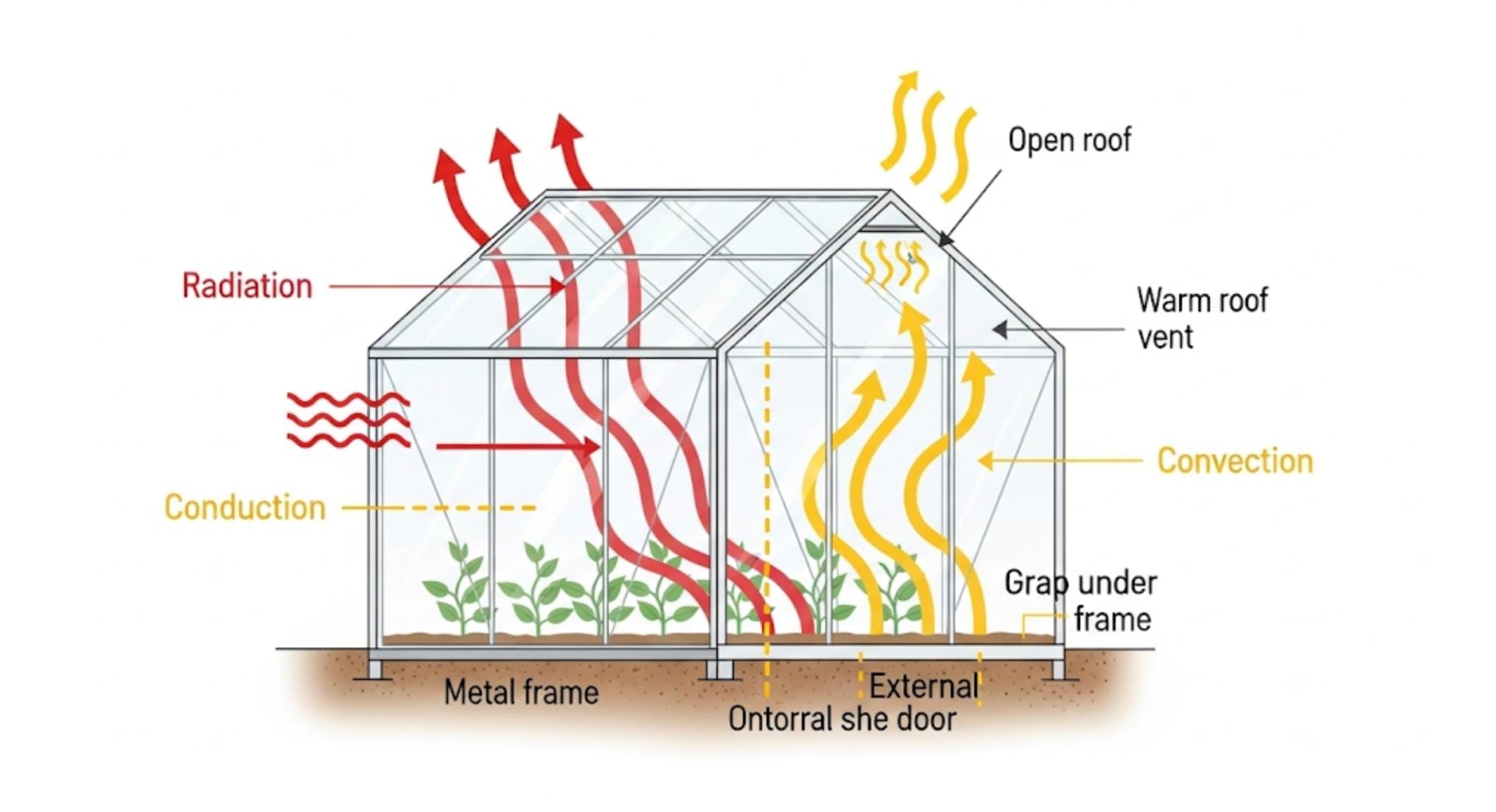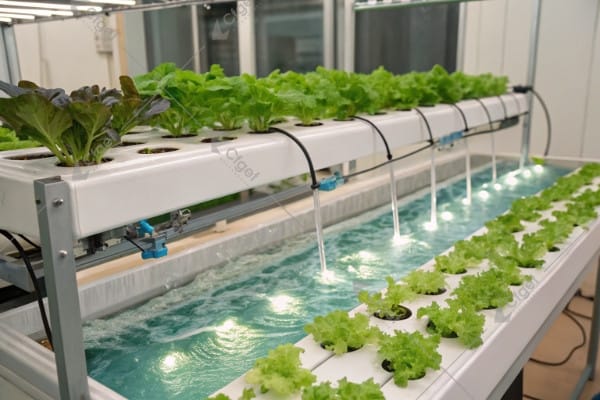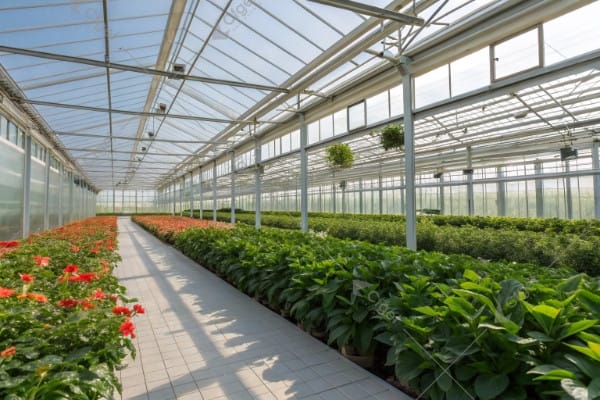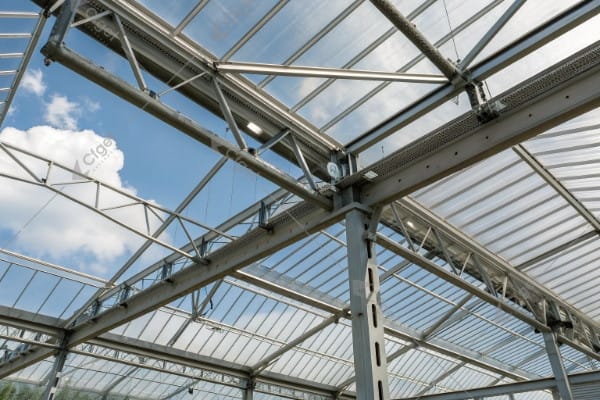Winter freezes can destroy months of hard work in your greenhouse overnight. Many growers face devastating crop losses and skyrocketing energy bills because they rely on inadequate heating solutions during cold months.
Greenhouses stay warm in freezing weather through a combination of efficient heating systems, proper insulation, thermal mass to store heat, and strategic design elements. Commercial operations typically employ top and four-sided insulation systems with automated energy curtains, while maintaining temperatures between 10-21°C depending on crop requirements.
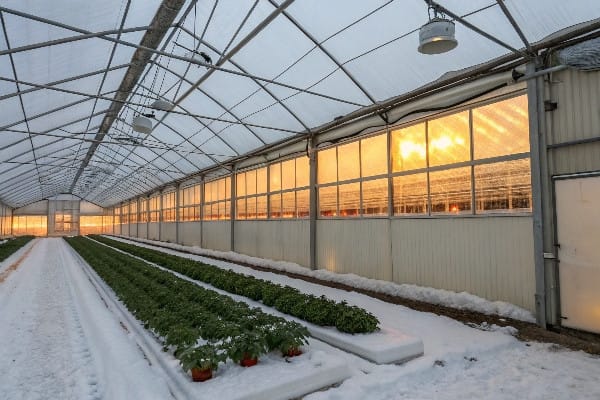
After nearly three decades in the greenhouse industry, I’ve seen firsthand how proper winter preparation makes the difference between thriving crops and total failure. Our team at CFGET has helped growers across diverse climates—from the harsh winters of Central Asia to the seasonal cold snaps in Southeast Asia—implement effective heating strategies. Let me share what works based on our experience with thousands of installations worldwide.
You might like:——Designing the Perfect Cannabis Greenhouse: Climate Control, Lighting & Structure?
You might like:——Winter Greenhouse Heating Strategies: Keeping Your Plants Warm Efficiently?
What are the Best Ways to Heat a Greenhouse in Winter?
Many greenhouse operations waste thousands on inefficient heating systems. I’ve visited facilities where poor heating design forces growers to spend 40-50% more on energy costs than necessary while still struggling to maintain consistent temperatures.
The most effective greenhouse heating methods include hydronic systems (hot water pipes or radiant floor heating), forced air heaters, infrared heating, and CO₂-generating combustion units. For commercial operations, hydronic systems typically offer the best efficiency, temperature uniformity, and plant-friendly heat distribution.
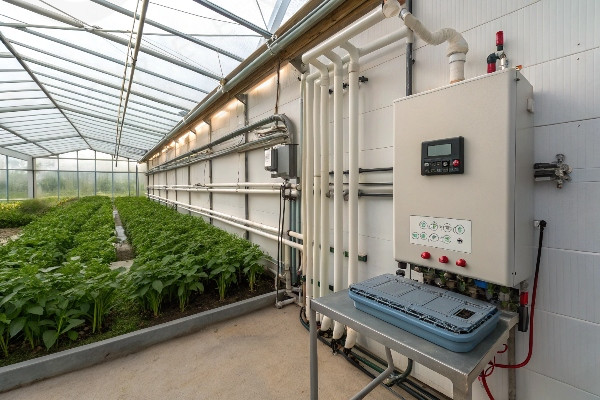
When I visited a large tomato producer in Kazakhstan last year, they were struggling with cold spots and temperature fluctuations despite investing in expensive heating equipment. The problem wasn’t their heating capacity but rather the distribution approach. After reconfiguring their system to incorporate perimeter heating pipes and improving air circulation, they achieved uniform temperatures while reducing fuel consumption by 23%.
The choice of heating system significantly impacts both operating costs and crop quality. Each method has distinct advantages depending on greenhouse size, crop type, local climate, and available energy sources. Based on our experience installing systems across diverse climates, I’ll outline the primary options and when each performs best.
Hydronic heating systems circulate hot water through pipes positioned strategically throughout the greenhouse. These systems excel in larger commercial operations for several reasons. First, water transfers heat more efficiently than air, providing even temperature distribution. Second, the pipe network can be arranged to create microclimates within the greenhouse—placing more pipes in colder zones like perimeters and fewer in naturally warmer areas. In a 5-hectare rose growing operation we set up in Ukraine, we placed 60% of the heating pipes along exterior walls and near the roof, effectively creating a thermal barrier that prevented cold air infiltration.
Forced air systems, including unit heaters and fan tubes, offer lower installation costs but typically higher operating expenses. They heat air directly and use fans to distribute warmth throughout the structure. These systems respond quickly to temperature changes but can create hot and cold spots if improperly designed. For crops sensitive to direct hot air, like certain ornamentals, we typically recommend deflectors and carefully positioned circulation fans. When implementing a forced air system for a flower grower in Vietnam, we integrated horizontal air flow fans that reduced temperature variation from 7°C to just 2°C across their facility.
Infrared heating provides direct radiant heat to plants and soil rather than heating the air. This approach is particularly effective in structures with poor insulation or in production areas requiring different temperature zones. In a research project we conducted with a university in Poland, infrared heating reduced energy consumption by 31% compared to forced air in a poorly insulated greenhouse, as it focused energy on warming plants directly rather than the entire air volume.
An often overlooked benefit of modern CO₂-generating heating systems is their dual function. These units not only provide heat but also supply carbon dioxide that enhances photosynthesis. For vegetable producers, this can boost yields by 15-30% during winter months when ventilation is minimal and CO₂ levels would otherwise be depleted. When we installed this type of system for a cucumber grower in Finland, they reported a 22% increase in winter production beyond what thermal benefits alone would explain.
Heating System Comparison for Commercial Greenhouses:
| Heating System | Installation Cost | Energy Efficiency | Temperature Uniformity | Maintenance | Ideal Applications |
|---|---|---|---|---|---|
| Hydronic Pipe Systems | High | Excellent | Very Good | Low | Large commercial operations, cold climates |
| Radiant Floor Heating | Very High | Excellent | Excellent | Very Low | Premium operations, propagation houses |
| Forced Air Heaters | Low | Fair | Fair | Moderate | Small/medium houses, supplemental heating |
| Unit Heaters with HAF Fans | Moderate | Good | Good | Moderate | Medium greenhouses, budget operations |
| Infrared Heating | Moderate | Very Good | Good (at plant level) | Low | Research facilities, zoned production |
| CO₂-Generating Units | Moderate-High | Good | Good | Moderate | Vegetable production, sealed greenhouses |
How Important is Insulation for Winter Greenhouse Warmth?
Poor insulation is often the hidden culprit behind excessive heating costs. Many growers invest in powerful heating systems while ignoring basic insulation, essentially paying to heat the outdoors as warmth escapes through gaps, single-layer coverings, and thermal bridges.
Proper insulation is critical for winter greenhouse operation, typically reducing heating costs by 30-60%. Effective insulation strategies include thermal energy curtains, double or triple-layer coverings, insulated north walls, foundation insulation, and draft sealing. For commercial operations, automated curtain systems provide the best balance of daytime light and nighttime insulation.
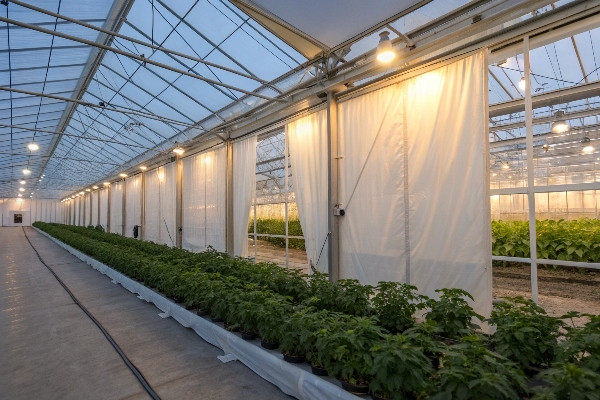
I remember visiting a client’s greenhouse in northern China during winter. Despite having heating capacity that should have been more than adequate, they struggled to maintain temperatures and faced fuel bills three times higher than necessary. The problem was immediately evident: they had invested in expensive heating equipment but had single-layer glass with aluminum framing creating significant thermal bridges, and no energy curtains. Within two months of implementing proper insulation, their heating costs dropped by 47%.
Greenhouse insulation functions on multiple levels, creating a comprehensive thermal barrier between the protected growing environment and harsh exterior conditions. Our approach at CFGET involves analyzing and addressing each potential heat loss pathway to develop an integrated insulation strategy tailored to specific climatic challenges and crop requirements.
Thermal energy curtains represent one of the most effective insulation investments for commercial operations. These automated systems deploy horizontally above the crop area, essentially creating a lower ceiling that reduces the volume of air requiring heating. Modern energy curtains can reduce nighttime heat loss by 35-65% depending on the material composition. In a large commercial installation we completed near Moscow, the combination of aluminized energy curtains deployed at night and clear curtains used during snowy days reduced annual heating costs by approximately 42% compared to their previous uncurtained system.
The covering material itself provides the primary insulation barrier in any greenhouse. While single-layer glass or plastic film offers minimal insulation (R-values of 0.9-1.0), double-layer systems significantly improve performance. An inflated double-poly film system provides an R-value around 1.5-1.8, while double-glazed glass with low-E coatings can achieve R-values of 2.5-3.5. For a pepper grower in Estonia facing temperatures below -25°C, we implemented a triple-layer covering system that incorporated two layers of polycarbonate with an intermediate ETFE film, achieving an R-value approaching 4.0 while maintaining 76% light transmission.
Four-sided insulation, as mentioned in our research insights, creates a comprehensive thermal envelope. This approach is particularly effective in extremely cold climates where every portion of the greenhouse surface requires protection. For some clients in Kazakhstan and northern Europe, we’ve implemented supplemental perimeter insulation blankets that automatically deploy vertically along side walls during extreme cold events, providing additional protection beyond standard energy curtains.
Foundation insulation is frequently overlooked yet crucial for preventing ground-level cold infiltration. Heat loss through uninsulated foundations and perimeter areas can account for 10-15% of total greenhouse energy consumption. For a research greenhouse we designed in Sweden, extending rigid foam insulation 60cm below ground level around the entire perimeter reduced overall energy consumption by 12% compared to standard foundation details.
For operations where budgets are limited, strategic partial insulation can provide significant benefits. Insulating north-facing walls with reflective, insulated panels not only reduces heat loss but can actually improve light levels by reflecting sunlight back onto crops. When we implemented this approach for a flower grower in Turkey, they achieved a 24% heating cost reduction while unexpected increasing light levels by approximately 8% on cloudy days.
Insulation Strategy Effectiveness Ranking:
| Insulation Method | Heat Retention Improvement | Light Transmission Impact | Initial Cost | Operational Complexity | Payback Period |
|---|---|---|---|---|---|
| Thermal Energy Curtains | 35-65% | Minimal (deployed at night) | Moderate-High | Low (automated) | 1-3 years |
| Double-layer Coverings | 25-45% | 10-15% reduction | Moderate | None | 2-4 years |
| Perimeter Insulation Blankets | 15-25% | None (side walls) | Moderate | Low (automated) | 2-4 years |
| Insulated North Wall | 10-20% | Improved (reflectivity) | Low-Moderate | None | 1-2 years |
| Draft Sealing | 5-15% | None | Low | Low | <1 year |
| Foundation Insulation | 8-15% | None | Moderate | None | 3-5 years |
Can You Heat a Greenhouse Without Electricity?
Power outages during winter storms can quickly become greenhouse emergencies. Many growers lack reliable backup systems, risking complete crop loss during extended electrical failures when temperatures plummet.
Several non-electric greenhouse heating methods exist, including passive solar design with thermal mass, compost heat generation, rocket mass heaters, and direct-fired propane/natural gas systems. While commercial operations typically require some electricity for controls, many heating systems can operate with minimal electrical requirements and appropriate backup power solutions.
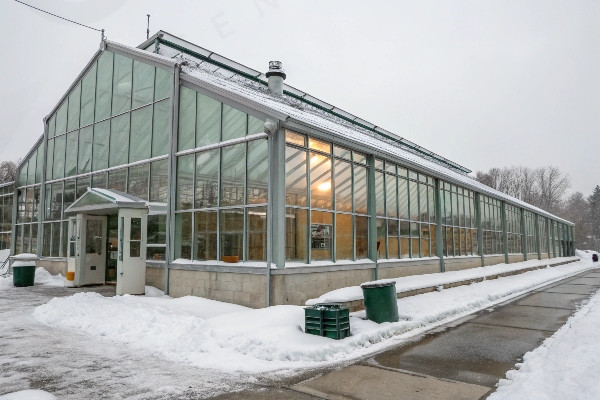
During a consultation in rural Mongolia, I worked with growers who had limited access to reliable electricity but needed year-round production despite temperatures reaching -30°C. By implementing a combination of passive solar design, massive thermal storage, and simple rocket mass heaters with heat-storing bench systems, they maintained viable growing temperatures even during multi-day periods without power.
The challenge of heating without electricity has become increasingly relevant as climate destabilization causes more frequent power disruptions. While most commercial operations will maintain some minimal electrical capacity through generators or battery systems, understanding heating options with minimal electrical dependence is valuable for resilience planning.
Passive solar design represents the foundation of electricity-free greenhouse heating. This approach integrates physical design elements that maximize solar gain during the day and minimize heat loss at night. Key elements include proper orientation (typically east-west lengthwise alignment), optimal roof angles to maximize winter sun exposure, and strategic thermal mass placement. In a project for a university in Turkey, we designed a passive solar greenhouse that maintained temperatures at least 10°C above ambient even during cloudy winter periods without supplemental heating, primarily through carefully calculated roof angles and 20,000 liters of water-based thermal storage.
Thermal mass functions as a heat battery, absorbing energy during daylight hours and releasing it gradually when temperatures drop. Water provides the most efficient commonly available thermal storage medium, storing approximately five times more heat per unit volume than concrete or stone. For a commercial grower in Georgia (the country), we integrated a sophisticated thermal storage system consisting of black-painted water tanks strategically positioned to receive direct sunlight during winter days. This system provided approximately 40% of their total heating requirements without any electrical input.
Compost heating systems harness the natural decomposition process, which can generate temperatures of 55-65°C within well-designed compost beds. These systems typically incorporate heat exchange pipes running through active compost piles, transferring heat to the greenhouse through water circulation or direct air exchange. While challenging to implement at large commercial scales, this approach works effectively for sections of larger operations, particularly for propagation areas requiring bottom heat. A mushroom producer in Ukraine we consulted with developed a hybrid system where compost heat maintained propagation temperatures while conventional heating handled the main production area.
Rocket mass heaters represent an evolution of traditional wood heating that achieves extremely high combustion efficiency while storing heat in thermal mass. These systems burn wood at very high temperatures in a specialized combustion chamber, then route the hot exhaust gases through thermal mass (typically cob, concrete, or water tanks) before exiting. For smaller commercial operations in regions with abundant wood resources, these systems can provide significant heating with minimal ongoing fuel costs. A flower grower in Romania implemented a rocket mass system that reduced their winter heating costs by approximately 60% compared to their previous propane system.
Direct-fired natural gas or propane heaters can operate without electricity, though they require careful implementation to address both safety concerns and the moisture and ethylene they produce during combustion. Modern direct-fired units with proper venting can function effectively as emergency backup systems during power outages. For several clients in areas with unreliable power, we’ve designed hybrid systems where conventional hydronic heating handles normal operation, but thermostatically-controlled direct-fired units with battery-powered ignition provide emergency backup during outages.
Non-Electric Heating Methods Comparison:
| Heating Method | Heat Output Capacity | Implementation Complexity | Ongoing Maintenance | Best Applications | Limitations |
|---|---|---|---|---|---|
| Passive Solar with Thermal Mass | Low-Moderate | High (design phase) | Very Low | Supplemental heating, mild climates | Limited capacity in extreme cold/cloudy periods |
| Compost Heating Systems | Low-Moderate | Moderate | High | Propagation areas, small operations | Difficult to scale, inconsistent output |
| Rocket Mass Heaters | Moderate-High | Moderate | Moderate | Small-medium operations, areas with wood resources | Labor intensive, requires specific skills |
| Direct-Fired Propane/Natural Gas | High | Low | Low | Emergency backup, remote locations | Moisture/CO₂ production, safety concerns |
| Solar Air Heaters | Low | Low | Very Low | Daytime supplemental heating | Night ineffectiveness, limited capacity |
| Geothermal Heat Exchange | Moderate-High | Very High | Low | Long-term commercial operations | High initial investment, site limitations |
What Temperature Should a Greenhouse Be Kept At in Winter?
Setting incorrect winter temperatures wastes energy and compromises crop health. I’ve consulted with many operations maintaining unnecessarily high temperatures that increased heating costs by 25-40% while actually reducing crop quality through excessive stretching and disease pressure.
Optimal winter greenhouse temperatures vary by crop type. Vegetables like tomatoes and cucumbers typically require 18-21°C during day and 16-18°C at night. Cold-tolerant crops like lettuce perform well at 10-15°C. Ornamentals vary widely, with some flowering plants needing 12-14°C night temperatures to initiate blooming. Maintaining proper day-night temperature differential (DIF) is often more important than absolute temperatures.
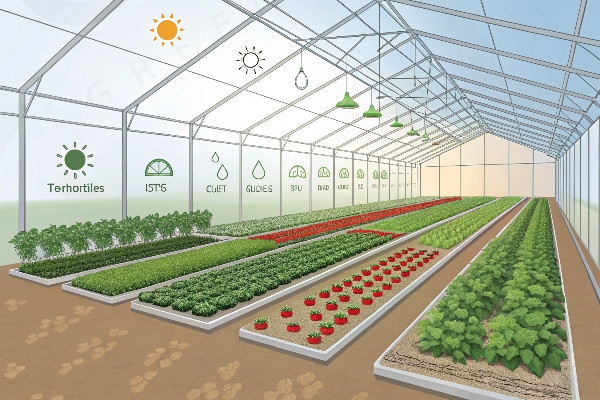
One of the most significant improvements I helped implement was for a mixed-crop greenhouse operation in Hungary that had been maintaining uniform 21°C temperatures throughout their facility. By creating temperature zones based on crop requirements and implementing day-night temperature differential1s, they reduced heating costs by 34% while simultaneously improving crop quality and reducing disease pressure.
Temperature management represents one of the most critical aspects of winter greenhouse operation, directly impacting both crop quality and operating costs. The science of greenhouse crop temperature management2 involves understanding not just absolute temperature targets but also the timing, duration, and differential between day and night temperatures that trigger specific physiological responses in plants.
For vegetable production, temperature requirements vary significantly by crop and growth stage. Tomatoes typically perform best with daytime temperatures of 21-24°C and night temperatures of 16-18°C. This day-night differential (positive DIF) promotes compact, strong growth and optimal fruit development. During a project with a major tomato producer in Poland, we implemented precise temperature zones that provided different night temperatures based on crop development stage – maintaining 17°C for plants in vegetative growth and 15.5°C for plants in heavy fruiting stages. This approach reduced energy consumption by 11% while increasing marketable yield by 7%.
Leafy greens and cold-tolerant vegetables can be produced successfully at substantially lower temperatures. Lettuce, spinach, and kale typically perform well with day temperatures of 10-15°C and night temperatures of 7-10°C during winter months. For a large lettuce producer in Sweden we worked with, maintaining these lower temperature targets allowed winter production with approximately 40% lower heating costs compared to conventional vegetable crops. Additionally, these cooler temperatures reduced pest pressure and extended harvest periods.
Ornamental crops present more complex temperature management challenges due to their diverse requirements and the specific temperature signals many flowering plants need to initiate bloom. Poinsettias, for instance, require precise temperature management with night temperatures of 16-18°C during vegetative growth, dropping to 13-15°C to initiate bract coloration. For a poinsettia grower in Germany, we designed a zone-specific temperature management system that maintained four distinct temperature regimes corresponding to different production stages, optimizing both energy use and crop timing.
Many crops benefit from negative DIF management – where night temperatures are maintained slightly higher than day temperatures – to control plant height and improve quality. This counterintuitive approach can both improve crop quality and reduce overall energy consumption by shifting heating demand to night hours when heating is more efficient due to reduced air exchange. When implementing this strategy for a lily grower in the Netherlands, we achieved both improved stem strength and a 9% reduction in heating costs.
Temperature integration represents an advanced energy-saving approach3 that focuses on maintaining appropriate average temperatures over 24-hour periods rather than rigid setpoints. This strategy allows temperatures to fluctuate within acceptable ranges, typically allowing lower temperatures during periods of high heating costs or limited capacity. Our implementation of temperature integration control for a commercial vegetable grower in Finland reduced their peak heating demand by 22% while maintaining equivalent crop performance by allowing wider temperature fluctuations during extreme weather events but compensating during moderate periods.
For mixed-crop operations, creating separate temperature zones through curtain walls, separate control systems, or physically separated bay areas can optimize both crop production and energy efficiency. When redesigning a diversified growing operation in Lithuania, we implemented five distinct temperature zones ranging from 8°C for cold-tolerant crops to 20°C for tropical ornamentals, reducing their overall energy consumption by 27% compared to their previous uniform temperature approach.
Optimal Winter Temperature Guidelines by Crop Category:
| Crop Type | Day Temperature | Night Temperature | Acceptable Fluctuation | Critical Minimum | Benefits of Proper Temperature Management |
|---|---|---|---|---|---|
| Tomatoes | 21-24°C | 16-18°C | ±2°C | 10°C | Reduced disease, improved fruit set, compact growth |
| Cucumbers | 22-26°C | 18-20°C | ±2°C | 12°C | Faster production, reduced male flowers, better quality |
| Lettuce/Greens | 10-15°C | 7-10°C | ±3°C | 5°C | Slower bolting, reduced tip burn, energy savings |
| Herbs | 15-18°C | 12-15°C | ±3°C | 8°C | Oil content, compact growth, disease reduction |
| Flowering Potted Plants | 16-21°C | 13-16°C | ±2°C | 10°C | Bloom initiation, compact habit, reduced stretching |
| Cut Flowers | 15-18°C | 12-15°C | ±2°C | 8°C | Stem strength, flower quality, timing control |
| Propagation Areas | 21-24°C | 18-21°C | ±1°C | 15°C | Rooting success, reduced losses, uniform development |
Conclusion
Effective winter greenhouse heating combines efficient heating systems, comprehensive insulation, backup strategies for power outages, and crop-specific temperature management. By implementing these strategies, commercial growers can maintain optimal growing conditions while minimizing energy costs, even in the most challenging winter climates.
Learn about the significance of day-night temperature differentials in promoting healthy plant growth and maximizing yields. ↩
Explore this resource to understand effective temperature management strategies that can enhance crop quality and reduce energy costs. ↩
Discover innovative energy-saving techniques that can help optimize greenhouse heating and reduce operational costs. ↩

